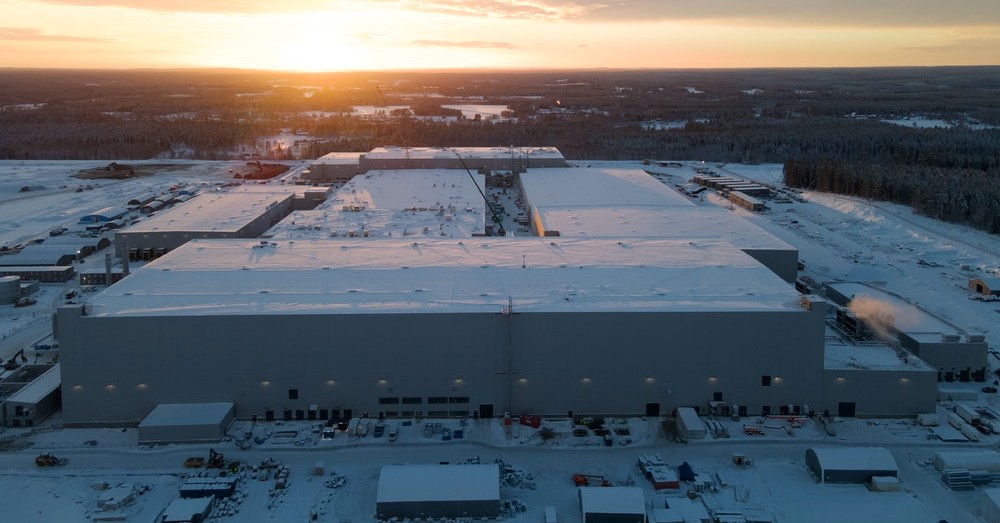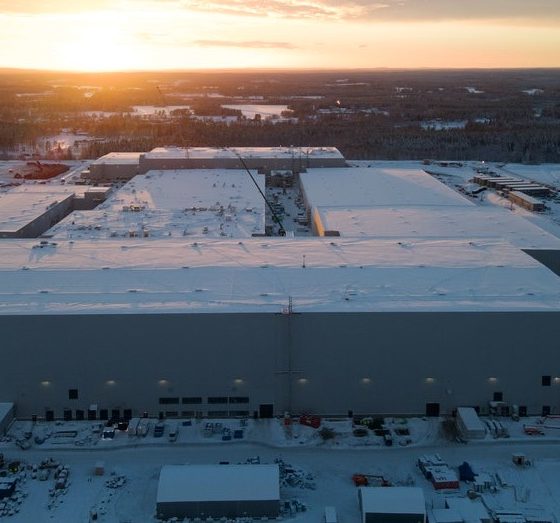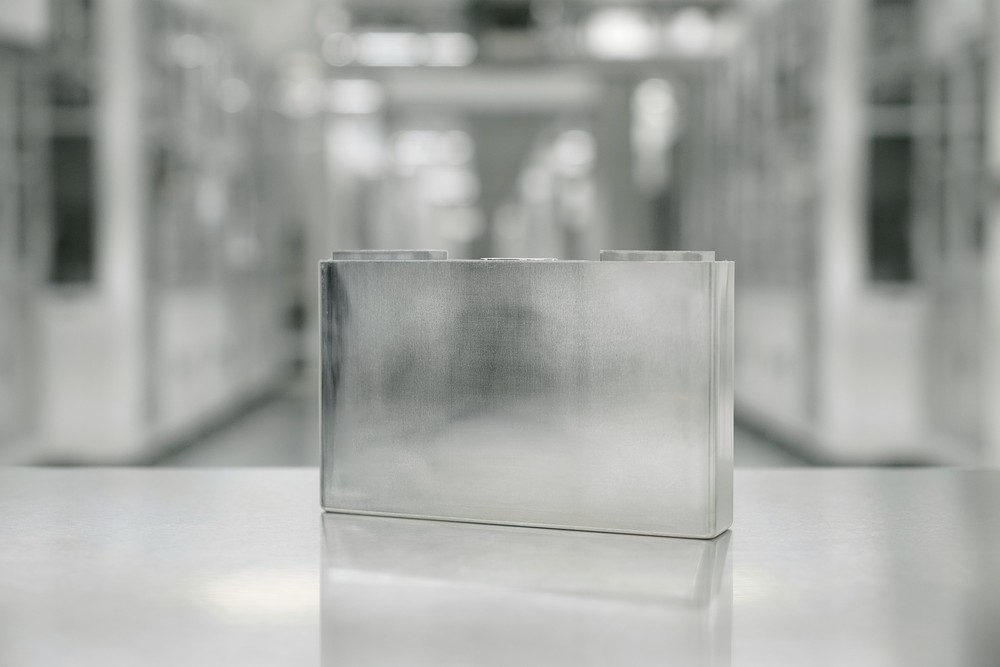

News
Northvolt announces new €4 Billion Battery Gigafactory in Northern Germany
Swedish battery company Northvolt announced today that it will build a new €4 Billion battery Gigafactory in Northern Germany in the city of Heide. The plant, known as “Northvolt Drei,” will be the company’s third production facility of at least 60 gigawatts of annual capacity and its first outside of Sweden.
Northvolt CEO Peter Carlsson said the area offered everything a battery company would want: support from local authorities and plenty of talent to pick from. “In Heide, we really found a spot where we could combine all our requirements: attracting talent and feeling the support for our aspiration of building the world’s greenest batteries,” Carlsson said. “With the energy mix in Schleswig-Holstein, with the offshore wind coming in, but also with the linkage to Denmark and Norway in the energy feed, we saw that this is probably the best spot for us in Germany to build this set-up.”
In December, Northvolt became the first European company to design, develop, and build a lithium-ion battery cell entirely in Europe. The cell was prismatic and not cylindrical as many EV enthusiasts are familiar with, like in Tesla’s vehicles. Prismatic cells consist of large sheets of anodes, cathodes, and separators sandwiched, rolled up, and pressed to fit into a metallic or hard-plastic housing in cubic form, according to AllAboutCircuits.
Northvolt Ett’s first Prismatic Lithium-ion cell. (Credit: Northvolt)
Germany is Europe’s leading EV battery production location with 485 gigawatt hours of capacity in both existing and planned facilities, Northvolt said in a statement citing Handelsblatt. With big-name EV players like Tesla committing to a massive Gigafactory facility near Berlin, which is set to launch in just one week, other battery makers have flocked to the region. CATL, SVOLT, and PSA Group have all announced projects in the region. Tesla also plans to build its 4680 cells in Germany in the coming years.
German authorities, including the country’s Trade and Invest group, voiced their support for Northvolt’s new facility.
“We welcome Northvolt’s decision to come to Heide, which gives the company not only proximity to Europe’s largest automotive market but also access to Germany’s highly skilled workforce as well,” Germany Trade & Invest (GTAI) CEO Robert Hermann said. “Northvolt is a great addition to the growing battery production landscape here in the heart of Europe.”
Heide is located near Hamburg, a large metropolitan area that has several technical colleges and universities known for its expertise in engineering. Additionally, Hamburg had the reputation of a city but also has a rural feel, as plenty of surround towns offer considerable landmass, which is suitable for manufacturing projects. Northvolt said Heide offered “the space required to establish a battery plant of sufficient size to leverage the economies of scale in production.”
“Germany Trade & Invest has been working together closely with Northvolt since late 2019 to find a site for the company’s German production facility, and we encouraged them to investigate sites in the north of the country as well as other regions because of the availability of renewable energy on Germany’s coasts,” GTAI automotive expert Stefan di Bitonto said. “Northvolt’s planned gigafactory in Heide is a further indication that the automotive industry in Germany is expanding beyond its traditional strongholds, as mobility is rethought during Germany’s transition to clean energy.”
I’d love to hear from you! If you have any comments, concerns, or questions, please email me at joey@teslarati.com. You can also reach me on Twitter @KlenderJoey, or if you have news tips, you can email us at tips@teslarati.com.

News
Tesla FSD fleet is nearing 7 billion total miles, including 2.5 billion city miles
As can be seen on Tesla’s official FSD webpage, vehicles equipped with the system have now navigated over 6.99 billion miles.

Tesla’s Full Self-Driving (Supervised) fleet is closing in on almost 7 billion total miles driven, as per data posted by the company on its official FSD webpage.
These figures hint at the massive scale of data fueling Tesla’s rapid FSD improvements, which have been quite notable as of late.
FSD mileage milestones
As can be seen on Tesla’s official FSD webpage, vehicles equipped with the system have now navigated over 6.99 billion miles. Tesla owner and avid FSD tester Whole Mars Catalog also shared a screenshot indicating that from the nearly 7 billion miles traveled by the FSD fleet, more than 2.5 billion miles were driven inside cities.
City miles are particularly valuable for complex urban scenarios like unprotected turns, pedestrian interactions, and traffic lights. This is also the difference-maker for FSD, as only complex solutions, such as Waymo’s self-driving taxis, operate similarly on inner-city streets. And even then, incidents such as the San Francisco blackouts have proven challenging for sensor-rich vehicles like Waymos.
Tesla’s data edge
Tesla has a number of advantages in the autonomous vehicle sector, one of which is the size of its fleet and the number of vehicles training FSD on real-world roads. Tesla’s nearly 7 billion FSD miles then allow the company to roll out updates that make its vehicles behave like they are being driven by experienced drivers, even if they are operating on their own.
So notable are Tesla’s improvements to FSD that NVIDIA Director of Robotics Jim Fan, after experiencing FSD v14, noted that the system is the first AI that passes what he described as a “Physical Turing Test.”
“Despite knowing exactly how robot learning works, I still find it magical watching the steering wheel turn by itself. First it feels surreal, next it becomes routine. Then, like the smartphone, taking it away actively hurts. This is how humanity gets rewired and glued to god-like technologies,” Fan wrote in a post on X.
News
Tesla starts showing how FSD will change lives in Europe
Local officials tested the system on narrow country roads and were impressed by FSD’s smooth, human-like driving, with some calling the service a game-changer for everyday life in areas that are far from urban centers.

Tesla has launched Europe’s first public shuttle service using Full Self-Driving (Supervised) in the rural Eifelkreis Bitburg-Prüm region of Germany, demonstrating how the technology can restore independence and mobility for people who struggle with limited transport options.
Local officials tested the system on narrow country roads and were impressed by FSD’s smooth, human-like driving, with some calling the service a game-changer for everyday life in areas that are far from urban centers.
Officials see real impact on rural residents
Arzfeld Mayor Johannes Kuhl and District Administrator Andreas Kruppert personally tested the Tesla shuttle service. This allowed them to see just how well FSD navigated winding lanes and rural roads confidently. Kruppert said, “Autonomous driving sounds like science fiction to many, but we simply see here that it works totally well in rural regions too.” Kuhl, for his part, also noted that FSD “feels like a very experienced driver.”
The pilot complements the area’s “Citizen Bus” program, which provides on-demand rides for elderly residents who can no longer drive themselves. Tesla Europe shared a video of a demonstration of the service, highlighting how FSD gives people their freedom back, even in places where public transport is not as prevalent.
What the Ministry for Economic Affairs and Transport says
Rhineland-Palatinate’s Minister Daniela Schmitt supported the project, praising the collaboration that made this “first of its kind in Europe” possible. As per the ministry, the rural rollout for the service shows FSD’s potential beyond major cities, and it delivers tangible benefits like grocery runs, doctor visits, and social connections for isolated residents.
“Reliable and flexible mobility is especially vital in rural areas. With the launch of a shuttle service using self-driving vehicles (FSD supervised) by Tesla in the Eifelkreis Bitburg-Prüm, an innovative pilot project is now getting underway that complements local community bus services. It is the first project of its kind in Europe.
“The result is a real gain for rural mobility: greater accessibility, more flexibility and tangible benefits for everyday life. A strong signal for innovation, cooperation and future-oriented mobility beyond urban centers,” the ministry wrote in a LinkedIn post.
News
Tesla China quietly posts Robotaxi-related job listing
Tesla China is currently seeking a Low Voltage Electrical Engineer to work on circuit board design for the company’s autonomous vehicles.

Tesla has posted a new job listing in Shanghai explicitly tied to its Robotaxi program, fueling speculation that the company is preparing to launch its dedicated autonomous ride-hailing service in China.
As noted in the listing, Tesla China is currently seeking a Low Voltage Electrical Engineer to work on circuit board design for the company’s autonomous vehicles.
Robotaxi-specific role
The listing, which was shared on social media platform X by industry watcher @tslaming, suggested that Tesla China is looking to fill the role urgently. The job listing itself specifically mentions that the person hired for the role will be working on the Low Voltage Hardware team, which would design the circuit boards that would serve as the nervous system of the Robotaxi.
Key tasks for the role, as indicated in the job listing, include collaboration with PCB layout, firmware, mechanical, program management, and validation teams, among other responsibilities. The role is based in Shanghai.
China Robotaxi launch
China represents a massive potential market for robotaxis, with its dense urban centers and supportive policies in select cities. Tesla has limited permission to roll out FSD in the country, though despite this, its vehicles have been hailed as among the best in the market when it comes to autonomous features. So far, at least, it appears that China supports Tesla’s FSD and Robotaxi rollout.
This was hinted at in November, when Tesla brought the Cybercab to the 8th China International Import Expo (CIIE) in Shanghai, marking the first time that the autonomous two-seater was brought to the Asia-Pacific region. The vehicle, despite not having a release date in China, received a significant amount of interest among the event’s attendees.








